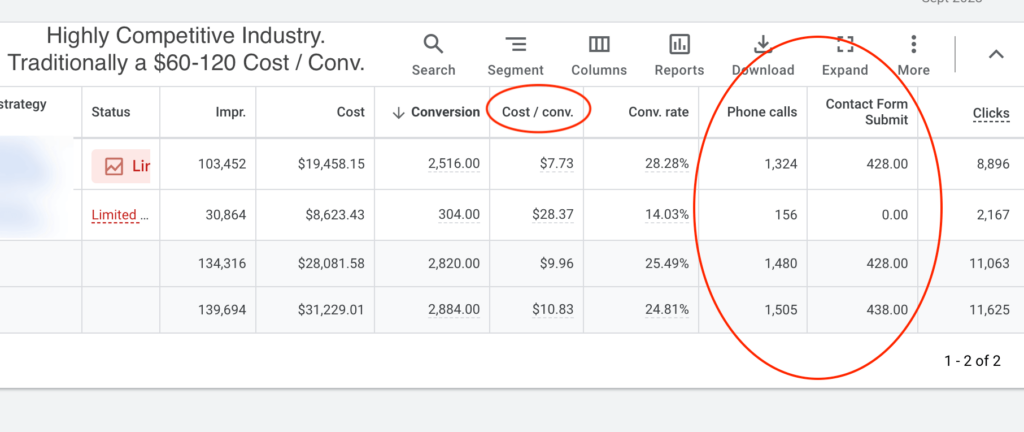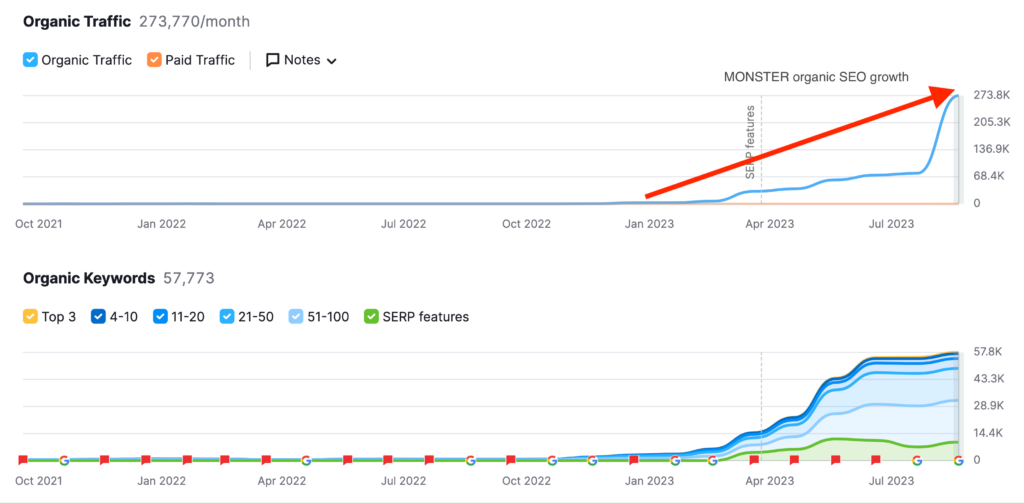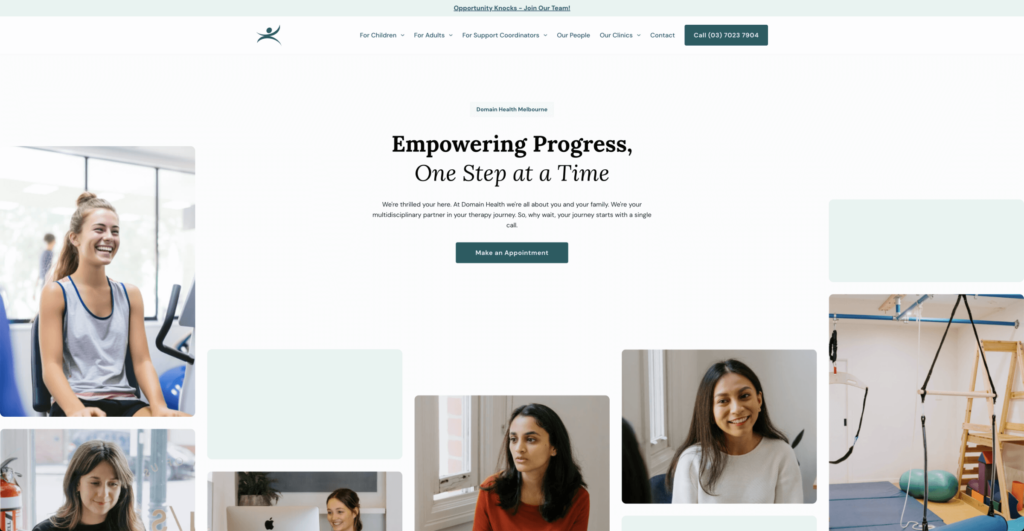

How to Get NDIS Clients: The Expert Guide

As Seen On
Getting NDIS clients is crucial for NDIS businesses to grow and thrive in Australia’s evolving disability services landscape. With the right strategies, your business can effectively reach your target NDIS audience and acquire more clients.
This comprehensive guide, written by the NDIS digital marketing experts at CJ&CO covers proven tactics to get more NDIS clients, including:
- Leveraging Google Ads
- Optimising Local SEO
- Creating compelling website content
- Building trust and credibility
- Partnering with other providers
Follow these tips to take your NDIS business to the next level.
Leverage Google Ads to Reach NDIS Clients
Google Ads, when used effectively, can be a game-changer for NDIS providers aiming to establish a strong online presence and attract potential clients. By focusing on a strategic approach tailored to your target audience, you can maximize your return on investment and drive meaningful traffic to your services. Here’s an in-depth exploration:

1. Research Your Target Audience
- Deep Dive into Demographics: Understanding the age, gender, location, and other demographic factors of your ideal clients can help tailor your ads to the right audience.
- Psychographic Profiling: Beyond demographics, dig into the challenges, goals, preferences, and online behaviors of your potential NDIS clients. This can help craft ads that not only reach them but also resonate deeply.
2. Choose Keywords Wisely
- Keyword Research Tools: Utilize tools like Google Keyword Planner to identify high-volume, relevant keywords that potential clients might use in their searches.
- Long-tail Keywords: These are longer and more specific keyword phrases. For example, instead of “NDIS services,” consider “NDIS physical therapy in Melbourne.” Such specificity can drive more relevant traffic and often has less competition, ensuring better ad placements.
3. Craft Compelling Ad Copy
- Unique Value Proposition (UVP): What sets your services apart? Highlight this UVP prominently in your ad headlines and descriptions.
- Emotional Connection: Tapping into emotions can be powerful. Craft copy that emphasizes the positive impact your services have on clients’ lives. Phrases like “Empowering You to Live Freely” can be impactful.
- Clear Call-to-Action (CTA): Guide potential clients on what to do next. Whether it’s “Learn More,” “Contact Us,” or “Sign Up Today,” a strong CTA can significantly boost conversions.
4. Optimize Landing Pages
- Consistency: Ensure that the message on your ad aligns seamlessly with the content on your landing page. This continuity builds trust and reduces bounce rates.
- Clear CTAs: Much like in your ad, have a clear and compelling CTA on your landing page, guiding visitors towards taking the desired action, be it signing up, contacting, or reading more.
- Page Load Times: Slow loading pages can deter potential clients. Optimize images, scripts, and other elements for faster loading.
5. Monitor and Adjust
- Analyze Performance Metrics: Regularly check metrics like click-through rate (CTR), cost-per-click (CPC), and cost-per-conversion. These insights can provide valuable information on what’s working and what needs tweaking.
- A/B Testing: Consider running different versions of your ads or landing pages to see which performs better. Such tests can lead to continuous improvements in your campaigns.
In conclusion, Google Ads offers NDIS providers a potent tool to connect with potential clients. However, its efficacy hinges on a strategic approach, continuous monitoring, and iterative improvements. By adopting these best practices, you can ensure that your ad spend translates into tangible results, bringing more clients on board and growing your NDIS business.
Boost Local SEO to Stand Out in Your Area
In the realm of NDIS services, a strong local presence is paramount. Many clients prefer providers who are accessible and familiar with the local community. Local SEO (Search Engine Optimization) is about ensuring that when potential clients in your vicinity search for NDIS services, your business stands out prominently. Here’s a more in-depth look at how to bolster your local SEO:

1. Optimise Google My Business (GMB)
- Complete Profile: A fully filled out GMB profile can significantly boost your local visibility. Make sure to include up-to-date photos, service offerings, business hours, contact information, and more.
- Engage Regularly: Post updates, news, or events related to your business on your GMB profile. Regular activity indicates that your business is active and engaged with the community.
- Manage Reviews: Encouraging satisfied clients to leave reviews can greatly improve your local credibility. However, if you’re bound by AHPRA guidelines, remember to ensure compliance and not solicit reviews.
2. Update Directory Listings
- Consistency is Key: Ensure that your NAP (Name, Address, Phone number) data is consistent across all online directories. Inconsistent data can confuse search engines and reduce your visibility.
- Diverse Directories: While platforms like Facebook and YellowPages are prominent, consider listing on other local directories or niche platforms relevant to NDIS services.
3. Create Location-Specific Content
- Tailored Landing Pages: Design landing pages targeting specific suburbs or towns. This can enhance relevance for local searches and improve your chances of ranking higher.
- Localized Blogs: Write blog posts focusing on local events, news, or issues related to NDIS. This not only shows your involvement with the community but also boosts local SEO.
4. Get Involved Locally
- Community Engagement: Sponsorship of local events, participation in community programs, or partnerships with local organizations can enhance your local reputation and visibility.
- Build Quality Backlinks: Engaging with the community can also lead to valuable backlinks from local websites, further boosting your local SEO. For instance, if you sponsor a local event, the event’s website might link back to yours.
5. Measure and Improve
- Data-Driven Decisions: Use tools like Google Analytics to track website traffic, call sources, and conversions originating from local searches. This data can provide insights into what’s working and what needs improvement.
- Continuous Optimization: SEO is an ongoing effort. Regularly review your local SEO strategies, update outdated information, and seek new opportunities to enhance your local visibility.
In conclusion, local SEO is about being the obvious choice when potential NDIS clients in your area are seeking services. With consistent effort and a strategy tailored to the local community’s nuances, you can ensure that your business stands out and attracts more local clients.
Craft Compelling Website Content
In today’s digital age, your website often serves as the front door to your NDIS business. An engaging, informative, and user-friendly website not only establishes credibility but also effectively communicates the value you offer to potential clients. Here’s a deeper exploration of the essential elements to consider:

1. Share Success Stories
- Real-life Impact: Narratives are powerful. Sharing authentic stories of individuals you’ve assisted can resonate deeply with potential clients. It provides tangible evidence of the difference your services make.
- Testimonials: Positive feedback from satisfied clients can be influential for those considering your services. Display these prominently, and if possible, accompany them with photos or videos for added authenticity.
- Case Studies: Dive deeper by illustrating specific scenarios where your intervention led to positive outcomes. This detailed approach can showcase your methods, expertise, and dedication.
2. Create Detailed Service Pages
- Comprehensive Information: For every service you provide, dedicate a page that dives into the specifics—how the service works, its benefits, and the expected outcomes.
- Visual Aids: Incorporate infographics, videos, or diagrams to explain complex processes or methodologies. Visual aids can often simplify complex topics and make them more digestible for the audience.
3. Publish Targeted Blog Content
- Stay Relevant: Regularly update your blog with topics that resonate with your NDIS audience. This not only positions you as a thought leader but also helps with search engine optimization.
- Diverse Topics: Cover a range of subjects, from funding options and navigating the NDIS landscape to specific disabilities and innovative therapy approaches. This ensures you cater to the varied interests and needs of your audience.
4. Respond to Reviews and Questions
- Active Engagement: Demonstrating that you value feedback and queries can significantly boost trust. Whether the feedback is positive or negative, a thoughtful response can show your commitment to client satisfaction.
- FAQ Section: Consider having a frequently asked questions section where you address common queries. This proactive approach can save potential clients time and demonstrate that you understand their concerns.
5. Optimize for User Experience
- Mobile Optimization: With the increasing reliance on mobile devices, ensure your website is mobile-friendly. This ensures a seamless experience, irrespective of the device used to access your site.
- Intuitive Navigation: A well-structured website with clear navigation menus ensures that visitors can easily find the information they seek.
- Speed and Performance: Slow-loading pages can deter potential clients. Regularly check your website’s speed and optimize images, scripts, and other elements to ensure fast loading times.
- Accessible Design: Make sure your website is accessible to all, including those with disabilities. This not only aligns with the inclusive nature of NDIS but also broadens your potential audience.
In conclusion, a compelling website is more than just an aesthetically pleasing design. It’s about delivering value, showcasing expertise, and ensuring a smooth user experience. Given its significance as the primary touchpoint for many potential clients, invest time and resources to make your website truly reflective of the quality and dedication you bring to the NDIS community.
The Marketing Smarts
So everyone has a website. The answer isn’t a website. The answer is actually a website with the marketing smarts built-in. An NDIS website that will rank, that will be visible in front of your target audience, build trust and credibility and convert website visitors into leads and new NDIS clients. There’s a heck of a lot thought that goes into building a website that will crush the competition.
Build Trust and Credibility
In the NDIS sector, trust isn’t just a nice-to-have—it’s an absolute necessity. Potential clients are entrusting providers with their well-being and quality of life, and they need to be assured that they’re making the right decision. Building and maintaining trust is a continuous effort, but the rewards in terms of client loyalty and reputation are invaluable.
1. Highlight Credentials
- Authenticity Matters: Presenting genuine credentials showcases professionalism and expertise. Ensure that all qualifications, certifications, and training of your staff are updated and easily accessible for potential clients.
- Affiliations: Highlight any associations with recognized industry bodies or institutions. These affiliations can serve as a stamp of approval and reflect adherence to industry standards.
2. Share Your NDIS Experience
- Narrative of Excellence: Share stories of how you’ve positively impacted the lives of NDIS clients. Use metrics, success rates, and testimonials to paint a picture of reliability.
- Consistency Over Time: Emphasize your years in business. Longevity can often signify stability, experience, and a history of client satisfaction.
3. Be Transparent
- Open Communication: Clarity in terms of services, policies, and pricing is paramount. Potential clients should never feel that they’re entering a relationship with hidden terms or conditions.
- Feedback Loop: Encourage questions and ensure that you address any concerns promptly. An open feedback mechanism can also demonstrate that you value client opinions and are always striving to improve.
4. Spotlight Your Specialties
- Unique Selling Proposition (USP): What sets you apart from the rest? It could be a unique therapy method, a specific expertise, or even a patented technique. Make sure this USP is front and center in all your communications.
- Tailored Services: Showcase how your offerings are specifically designed for NDIS needs, demonstrating a deep understanding and commitment to the sector.
5. Get Recognised
- Industry Awards: Pursuing and showcasing awards can provide external validation of the quality of your services. Such accolades can often sway potential clients who are on the fence.
- Media Presence: Engage with media to share your expertise, insights, and success stories. Regular media appearances or mentions can boost your brand’s credibility and visibility.
6. Authentic Imagery
- The Power of Authenticity: In an age where stock images are ubiquitous, using original photos of your team, facilities, and actual clients (with permission) can significantly enhance trust. It offers a genuine glimpse into your operations and the people behind the services.
- Professional Photography: While original photos are crucial, ensure they are of high quality. Consider hiring a professional photographer to capture your business’s essence, making sure it resonates with the authenticity and dedication you bring to the NDIS sector.
In conclusion, trust-building is an ongoing journey. It’s about consistent communication, transparency, and delivering on promises. In the NDIS landscape, where clients’ well-being is at stake, the significance of trust cannot be overstated. Prioritize it, and you’ll create lasting relationships that stand the test of time.
Offer Incentives and Promotions
In the competitive landscape of NDIS services, providing incentives and promotions can be the distinguishing factor that draws clients to your business over others. While it’s crucial to maintain the dignity and professionalism of care services, there are ethical and effective ways to implement incentives, especially for non-healthcare services like cleaning and lawn mowing. Here’s a deeper dive into the strategies:
1. Discounts for New Clients
- First Impressions Matter: Offering a discount or a free session can be the enticing factor that convinces potential clients to try out your services. This gesture demonstrates confidence in your services and provides a risk-free opportunity for clients to evaluate your offerings.
- Long-term Benefits: While you might take a small hit initially, the lifetime value of acquiring a loyal client can far outweigh the initial discount.
2. Give Referral Rewards
- Word of Mouth: Personal recommendations are incredibly influential. When existing clients refer new participants, it’s a testament to their trust and satisfaction with your services.
- Types of Rewards: Consider offering discounts on future services, gift cards, or even small merchandise. The gesture, no matter how big or small, shows appreciation and encourages more referrals.
3. Bundle Services
- Comprehensive Care: Bundling allows clients to get multiple services they need in one package, often at a reduced total cost. This not only provides them with convenience but also ensures that they receive a holistic service experience.
- Customized Packages: Tailor bundles to the specific needs of different client segments. For instance, a package could include both NDIS cleaning and lawn mowing for homeowners.
4. Highlight Limited-Time Offers
- Creating Urgency: Limited-time offers play on the principle of scarcity, prompting potential clients to take action before they miss out. This can be particularly effective during festive seasons or special occasions.
- Variety is Key: Rotate these offers periodically to keep things fresh and appealing. For instance, a summer special for lawn mowing or a spring cleaning discount.
5. Partner for Giveaways
- Collaborative Marketing: By teaming up with other providers, you can offer giveaways that provide a broader range of value to potential clients. This strategy not only attracts a larger audience but also divides the cost and effort of the promotional activity.
- Innovative Approaches: Think outside the box. Host joint events where attendees stand a chance to win free assessments, products, or services. Use social media platforms for online contests, where participants can win giveaways by engaging with your content.
In summary, offering incentives and promotions in a thoughtful and strategic manner can significantly boost client acquisition and retention. It’s essential, however, to ensure that these promotions align with the values and quality of your NDIS services, maintaining trust and credibility with your audience.
Partner with Complementary Providers
The power of collaboration cannot be emphasized enough in the NDIS landscape. By partnering with complementary providers, you can unlock a plethora of opportunities to serve clients better and expand your reach.
1. Cross-Promote Services
- Synergy in Services: Identify providers whose services align with yours but don’t directly compete. For instance, if you specialize in physical therapy, consider partnering with a speech therapist or an occupational therapist.
- Mutual Benefits: Cross-promotion benefits both parties. Shared marketing costs, combined efforts, and dual expertise can lead to a win-win situation. Jointly advertise services, distribute brochures, or even run combined promotional campaigns.
2. Offer Multidisciplinary Assessments
- Holistic Approach: NDIS clients often require multiple services to address their varied needs. By offering multidisciplinary assessments, you ensure clients receive a comprehensive evaluation of their needs from various experts in one place.
- Streamlined Service Delivery: This reduces the need for clients to visit multiple providers for assessments, making the process more efficient and convenient.
3. Coordinate Support Teams
- Integrated Care Network: Establish a trusted network of providers to ensure clients receive seamless support across different services. Such networks enhance the client’s journey, ensuring they get the best possible care at every stage.
- Referral System: Implement a referral system within your network, making it easy for providers to refer clients to one another based on specific needs. This not only ensures the client gets the right service but also helps providers within the network to grow their client base.
4. Share Events and Workshops
- Joint Initiatives: Hosting events, workshops, or support groups in collaboration with other providers can significantly increase participation. Combining resources and expertise leads to more impactful and informative sessions.
- Expand Reach: Promote these joint events across all partner platforms, newsletters, and social media channels. This ensures maximum visibility and allows both parties to tap into each other’s audience base.
5. Collaborate on Content Creation
- Shared Expertise: By collaborating on content, providers can bring varied perspectives and expertise to the table. This ensures that the content is comprehensive, informative, and caters to a wider audience.
- Diversify Content Types: Consider co-creating a variety of content – from blogs and guides to webinars and videos. This not only keeps the audience engaged but also positions you and your partners as thought leaders in the NDIS space.
Work with NDIS Marketing Experts Like CJ&CO
Most businesses come to us after working with another agency. And they all say the same thing “they had no idea what we do”. And they’re right. Most agencies haven’t a clue about the differences between SDA, STA, SIL, ADL, SLP, OT etc. We do. We’ve been there, got the t-shirt and wear it proudly. As you can see, marketing your NDIS business involves many moving parts. An experienced digital marketing agency can help streamline your strategy and drive leads for your NDIS business.
Our team at CJ&CO specialises in digital marketing for NDIS and healthcare businesses and has over half a decade of experience and $175 million in results under our belts. Our tailored services include:
- NDIS Lead Generation
- NDIS Google Ads Management
- NDIS Email Marketing
- NDIS Local SEO Optimization
- NDIS Website Design
- NDIS Content Marketing
- NDIS Social Media Marketing
- NDIS Online Reputation Management
We implement proven marketing tactics tailored for your NDIS business while you focus on service delivery. Our strategies help NDIS providers like you gain more quality clients and grow revenue.
Ready to take your marketing to the next level? Get in touch or request a free quote to discuss how we can help your NDIS business thrive online.
Summing up
With the NDIS expanding nationwide, competition is heating up. Standing out requires smart digital marketing focused on your niche, expertise and value for participants.
This guide outlined key strategies to help NDIS businesses like yours attract more clients by:
- Optimising your online visibility and discoverability
- Crafting messaging that engages your audience
- Building trust and credibility as a provider
- Creating urgency with promotions and incentives
- Collaborating for greater collective impact
Focus on continually improving in these areas. Execute targeted campaigns to get your brand in front of the right people. With the right approach, you can achieve sustainable growth and make a bigger difference in the lives of NDIS participants.
Frequently Asked Questions:
What is the National Disability Insurance Scheme (NDIS)?
The National Disability Insurance Scheme (NDIS) is a government-funded program that provides support and services to people with disabilities.
How can my business get involved with the NDIS?
There are a few different ways that businesses can get involved with the NDIS. One way is by becoming an approved provider of NDIS services. Another way is working with an organisation that provides support or services to people with disabilities.
What are some of the benefits of working with the NDIS?
Some benefits of working with the NDIS include having access to a large pool of potential clients, offering a wide range of services, and providing support that can make a difference in people’s lives.
How can I attract NDIS clients to my business?
You can attract NDIS clients to your business in a few different ways. One way is by making sure you’re registered with the NDIS. Another way is by marketing your business online or attending events and conferences related to the disability sector.
Casey Jones
Up until working with Casey, we had only had poor to mediocre experiences outsourcing work to agencies. Casey & the team at CJ&CO are the exception to the rule.
Communication was beyond great, his understanding of our vision was phenomenal, and instead of needing babysitting like the other agencies we worked with, he was not only completely dependable but also gave us sound suggestions on how to get better results, at the risk of us not needing him for the initial job we requested (absolute gem).
This has truly been the first time we worked with someone outside of our business that quickly grasped our vision, and that I could completely forget about and would still deliver above expectations.
I honestly can't wait to work in many more projects together!
Disclaimer
*The information this blog provides is for general informational purposes only and is not intended as financial or professional advice. The information may not reflect current developments and may be changed or updated without notice. Any opinions expressed on this blog are the author’s own and do not necessarily reflect the views of the author’s employer or any other organization. You should not act or rely on any information contained in this blog without first seeking the advice of a professional. No representation or warranty, express or implied, is made as to the accuracy or completeness of the information contained in this blog. The author and affiliated parties assume no liability for any errors or omissions.

